Updated: 2024-12-04
TaxCycle T2 is certified by the CRA for the electronic filing of slips and summaries related to the T106 Information Return of Non-Arm’s Length Transactions with Non-Residents. Here’s what you need to know to get set up and transmit T106 slips and summaries to the Canada Revenue Agency (CRA).
To electronically file the T106, you must have an EFILE number and password issued by the CRA.
If you are transmitting the T106 in TaxCycle T2, you can also use a Web Access Code (WAC) issued by the CRA.
To learn how to register for EFILE or request a WAC, read the Register for EFILE and Request a T2 WAC help topics.
EFILE Number and Password
To electronically file with the Canada Revenue Agency (CRA), you must have an EFILE number and password issued by the CRA.
- To register for EFILE and receive these credentials, go to the EFILE for electronic filers page.
- If you already have an EFILE number, you must complete a yearly renewal to receive a new password for the latest T1 tax season. Always use the latest password given to you.
The registration or renewal process includes a suitability screening. This process may take up to 30 days. To allow enough time for the review of your application before the filing season starts, we encourage you to renew your application as soon as possible.
Enter the CRA EFILE number and password in TaxCycle Options:
- If you have a file open, go to the File menu, then click Options. To open Options from the Start screen, click Options in the blue bar on the left side. (You can also access these EFILE options any time by clicking on the wrench icon in the Transmit sidebar.)
- On the left side of the screen, expand Transmission and then click on EFILE Accounts.
- Enter your CRA EFILE Number and EFILE Password.

Answer “Yes” to the T106 Question
TaxCycle triggers review messages and transmission functions for the T106 slips and summaries based on a question in the Filing section of the Info worksheet. Answer Yes to this answer.
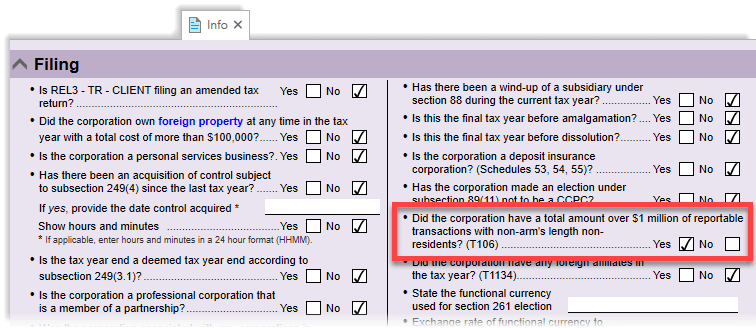
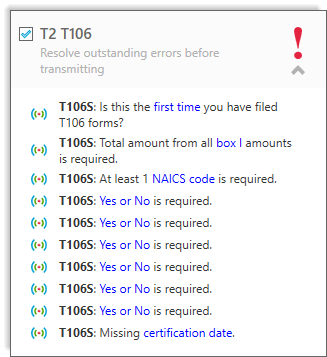 Complete the T106 Slips and Summary
Complete the T106 Slips and Summary
Once you answer Yes to the question on the Info worksheet, the T2 T106 box appears in the Transmit sidebar. It will show any outstanding errors preventing filing of the T106:
- Complete the T106 slips.
- Complete the T106S summary.
- To file amended, cancelled, or additional slips or summary, select the correct check box at the top of the forms. For more details, see the section on How to file amended T106 slips and summary, below.
- Click Transmit in the sidebar or press F12.
- Click once on the T106 box to expand it and see a list of all outstanding errors preventing filing of the T106.
- Click a blue link to jump to a field and address an issue.
T106 Certification Date
A review message will prompt you to enter a certification date on the T106S. The T106 uses the same date set for the T2 return. This information flows from the Filing section on the Info worksheet.
Confirm Signature of the T106
The CRA requires that the taxpayer sign a paper copy of the T106 before the preparer can electronically file it on their behalf. It is also important that you keep this signed form in your files should the CRA ask for it, as they regularly check with preparers.
By default, TaxCycle requires you to confirm that the taxpayer has signed the form before you can transmit it. Do this from the Transmit sidebar:
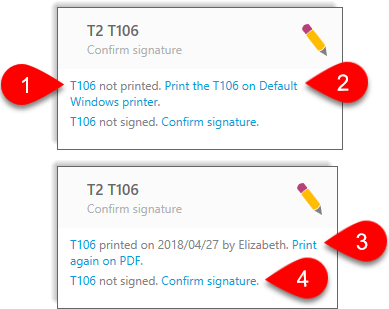 Click T106 link to open the form.
Click T106 link to open the form.- Click Print the T106 link to print the form from whatever printer is configured for single-form printing. This opens the Print/Generate forms dialog box, where you can change the printer/output settings. From this dialog box, click the Print or Generate button to print/PDF the form. (Read the Print/PDF a Form help topic to learn more about the options available from this box.)
- TaxCycle records the date and the name of the person who printed the form. Click the link to print it again if need be.
- Once you have a signed T106 on file, click the Confirm signature link. TaxCycle records the signing date and the name of the person who confirmed the signature.
You can disable the signature confirmation step. This skips the confirmation step, but will still see links to print and optionally log the T106 signature before transmitting. To learn how to do this, read the “Disable signature confirmation" section at the bottom of this page.
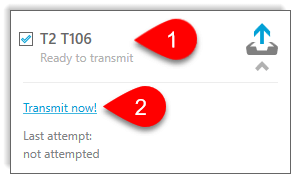
Transmit a Return
- Once you confirm the signature, the return becomes Ready to transmit.
- Click the Transmit now! link to begin the transmission.
You can also transmit other returns and requests (like T2 CIF or T1135) at the same time by using Transmit multiple. Learn how in the Transmit Multiple help topic.
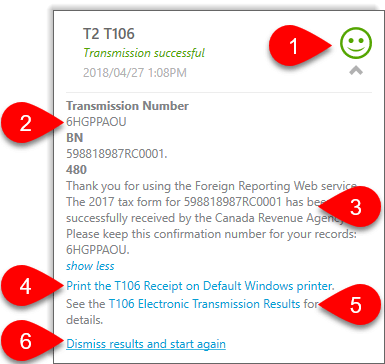
Successful Transmission Results
If a T106transmission is successful, you will see:
- The words Transmission successful in green text and green happy face. This is the same symbol that appears in the Client Manager for returns that have been successfully filed, and it also appears (white on blue) in the blue bar at the bottom of the window of any open tax return, so you can quickly see the current filing status.
- The box also shows the Confirmation number and Transmission number for future reference.
- Any messages returned from the CRA appear in this box. They begin with the number. Click the more link to see the full message.
- Click the Print the T106 Receipt link to give a copy of this information to your client.
- Click the T106 Electronic Transmission Results link to view the worksheet which contains a full list of the results from all transmission attempts.
- In the rare case you need to retransmit the form, click Dismiss results and start again.
Rejected Transmission with Errors
If a T106 transmission is rejected by the CRA due to errors, you will see
- Transmission rejected and a red sad face. This is the same symbol that appears in the Client Manager for transmissions that have failed, and it also appears (white on blue) in the blue bar at the bottom of the window of any open tax return, so you can quickly see the current status.
- Any error messages received from the CRA also appear in this box, starting with the error number. This number may be useful if you need to contact the CRA regarding an error.
- The longer error description usually contains information on what went wrong with the transmission, so you can work to correct it.
- Click the T106 Results link to view the worksheet which contains a full list of the results from all transmission attempts.
- When you have resolved the issue, click Dismiss all CRA messages and start again to retransmit. This rechecks the return for outstanding errors before returning to the transmission step.
Watermark
After successful transmission, the T106 summary and slips show a watermark—on screen and when printed—to remind you and your client that the statement has already been submitted to the CRA and the form should not be sent in again by mail.
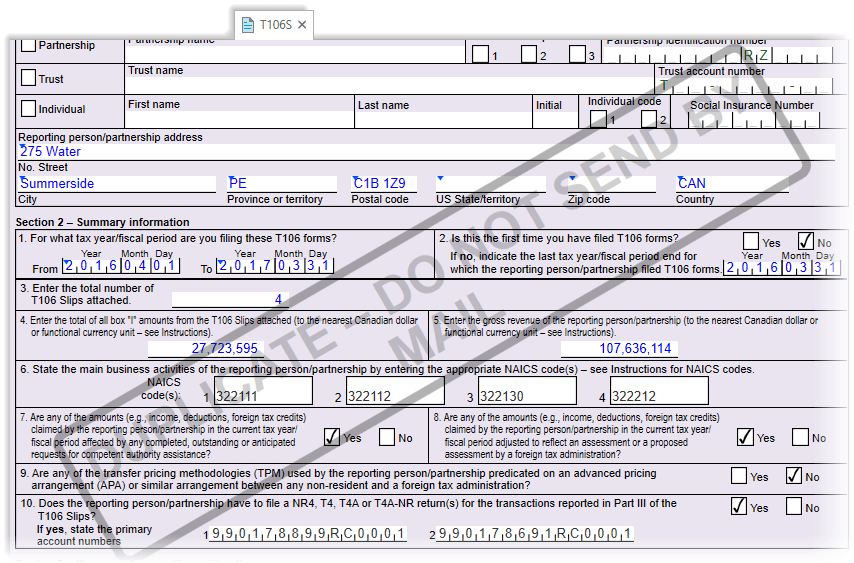
T106 Results Worksheet
The T106 Results worksheet lists the results of any attempts to electronically file a T106. Regardless of a successful or failed transmission, TaxCycle records the time and the result of the transmission, so you always have a complete record of transmission attempts and returned messages, even if you have to retransmit the return.
How to File Amended T106 Slips and Summary
- For any amended, cancelled or additional slips, check the appropriate box at the top of the affected T106 slip:
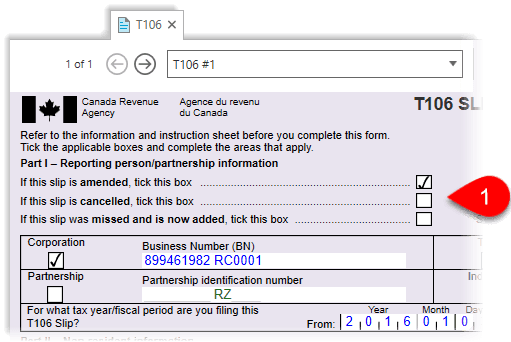
- Check the first box at the top of the T106S. This marks the form as amended and puts a watermark on the form.
- If the summary is amended in addition to the slips, check the second box.
- The field with the summary filing code will automatically change based on this selection.
- In the Transmit sidebar, click the link to Dismiss results and start again, then follow the same steps as above to the file return.
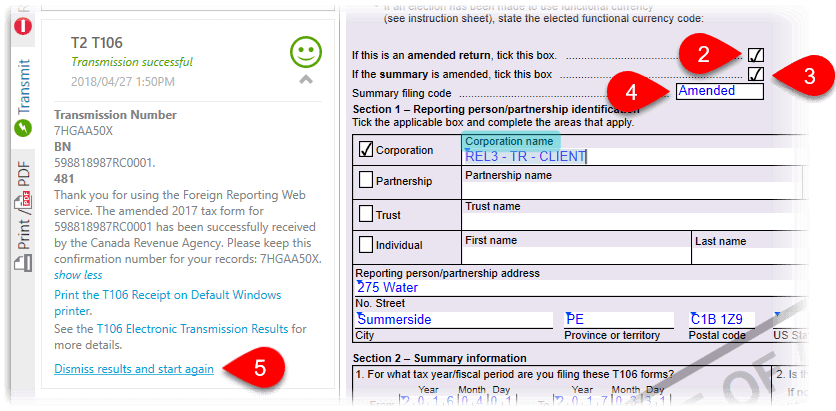
Transmission History
No matter what type of transmission you make (EFILE, ReFILE, PAD, T1135, etc.), each transmission attempt is recorded in the file history:
- Go to the File menu, then click on Info.
- Click on History.
- Find the record of the transmission in the list.
- Click the first save button (the one with the lightning bolt) to save a copy of the XML file that was transmitted to the CRA.
- Click the second save button (the one with the green arrow) to save a copy of the response sent back from the CRA.
- TaxCycle also updates the workflow information for the taxpayer. (See the Workflow Groups and Tasks help topic.)
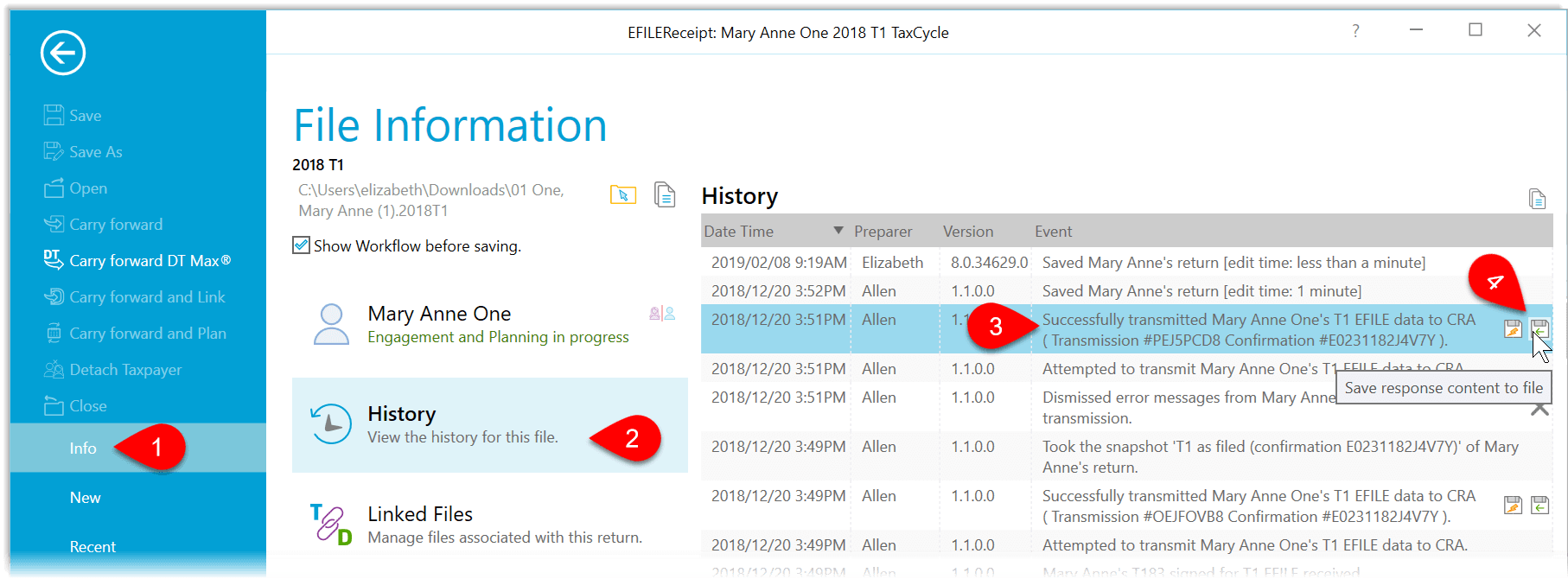
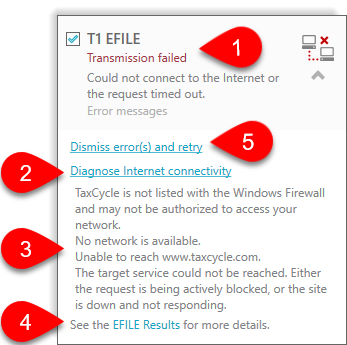
Internet Connectivity Issues
Transmissions will fail if your Internet connection isn’t working properly. If this happens, you will see (the following items and screen capture apply to all transmission types, not just T1 EFILE):
- The words Transmission failed and two computers with red dots between them. This means that TaxCycle could not connect with the CRA system and no attempt at filing the return was made.
- Click the Diagnose Internet connectivity link to see whether your Internet connection is working.
- TaxCycle will run a check on your Internet connection and display the results.
- The results of this transmission attempt are also recorded on the EFILE Results (or T1013 Results, etc.) worksheet. Click the link to open the worksheet.
- When your Internet connection is working again, click Dismiss error(s) and retry to try the transmission again.
Disable Signature Confirmation
The CRA and Revenu Québec expect a signed T183, TP1000, T1013, T1135, etc. before you transmit, but you are not required to log the signature confirmation in TaxCycle if your practice has another way of tracking this information. You can disable the signature confirmation step in options.
- If you have a file open, go to the File menu, then click Options. To open Options from the Start screen, click Options in the blue bar on the left side. (You can also access these options any time by clicking on the wrench icon in the Transmit sidebar.)
- On the left side of the screen, expand Transmission and then click on Workflow.
- On the right-hand side of the window, scroll to the table. In the row for the transmission type you require (for example, T1013 or T1 EFILE), clear the check box under the Documents Signed column.
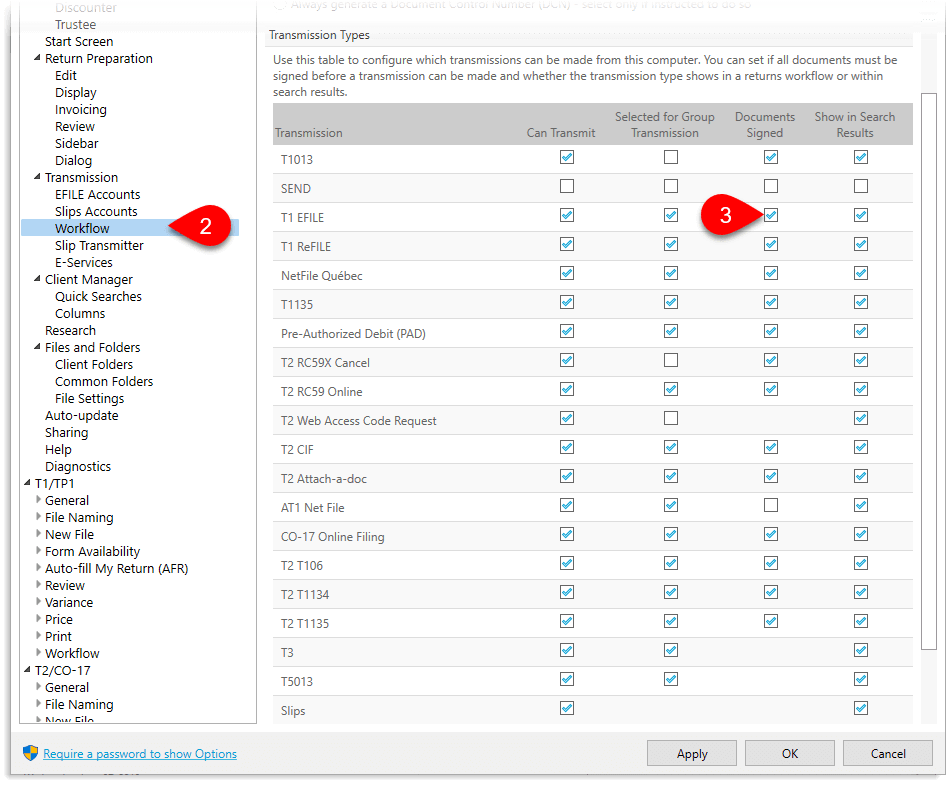
Set the Language for Transmission Results
You can set in which language(s) messages received in response to transmissions are recorded on the related worksheets (such as EFILE Results). Note that not all jurisdictions support messages in both English and French.
To set this option:
- If you have a file open, go to File menu, then click Options. To open Options from the Start screen, click Options in the blue bar on the left side. (You can also access these options any time by clicking on the wrench icon in the Transmit sidebar.)
- On the left side of the screen, expand Transmission and then click on Workflow.
- On the right side of the dialog box, choose one of the following options:
- The current TaxCycle language
- If available, both English and French
- Always in English
- Always in French



 Complete the T106 Slips and Summary
Complete the T106 Slips and Summary Click T106 link to open the form.
Click T106 link to open the form.







